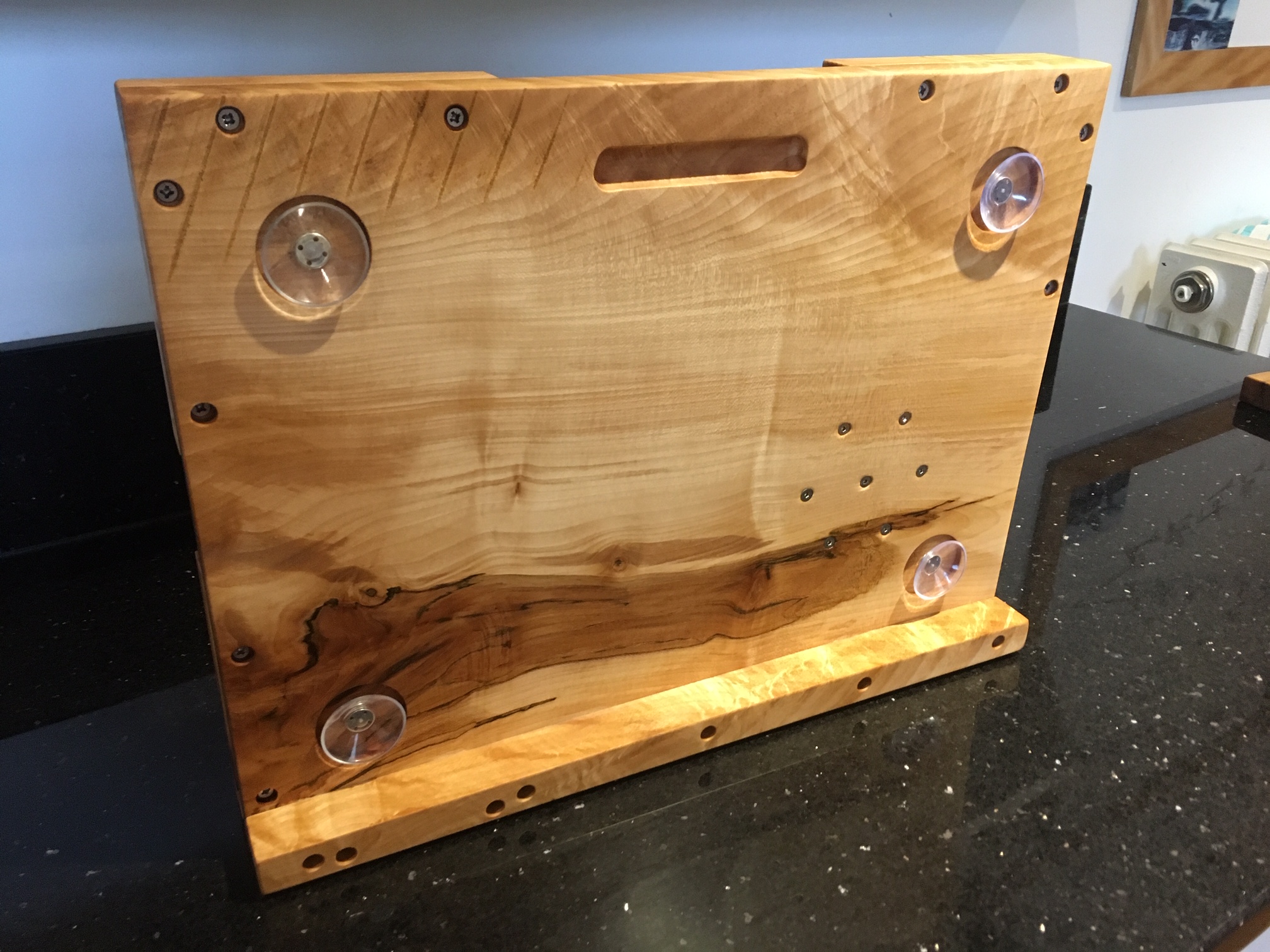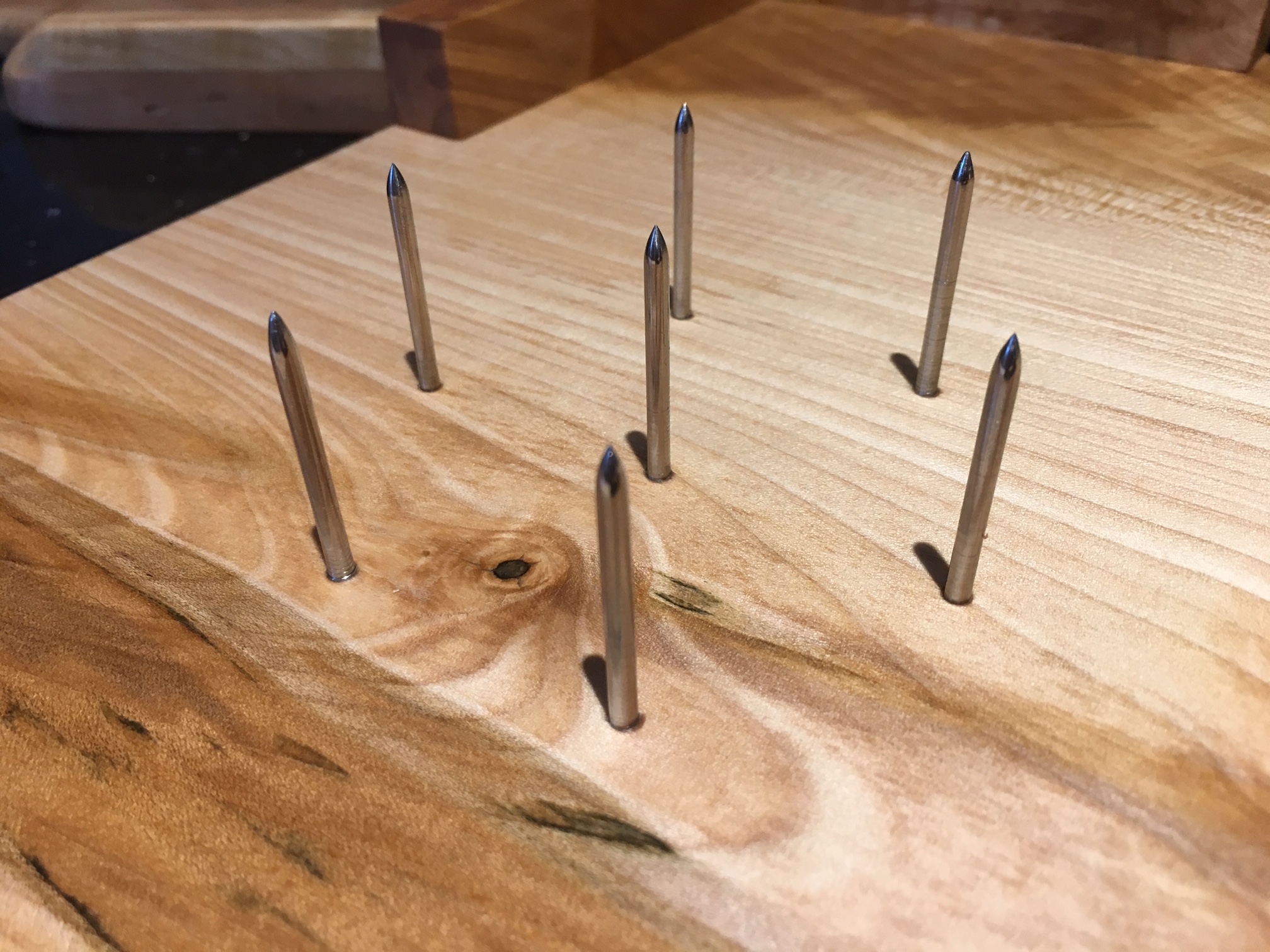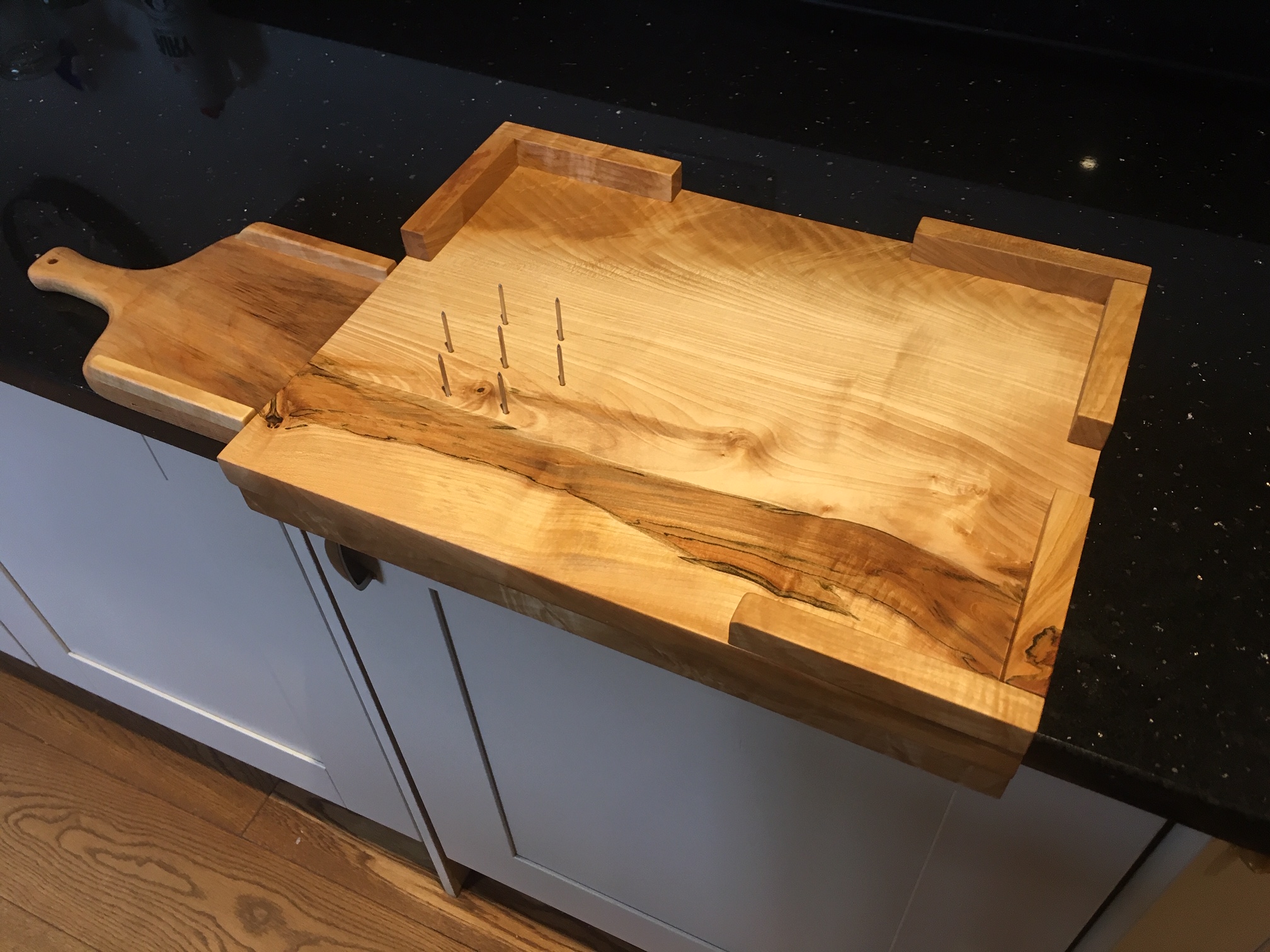A chap at work’s father was unwell and the illness has left him with use of only his left hand. To try and aid his recovery and return to normality they are trying to get him cooking again.
Like many of us blokes he’s a proud chap and any white plastic medical looking aids will end up in the bin. I was asked if I would glue a few bits of wood together and my colleague would bang some nails through it to copy a design on the web. Loving a challenge and the opportunity to do something different I said I’d help, it of course would not be a couple of bits of wood and some nails.
I’m going to make a coffee table using a slab of sycamore for the top, which required me to build a router flattening sled. I was practicing with the sled on a sizeable off-cut, which turned out to be chopping board sized.
Router sled set-up.

To hold the board in place it has sucker cups on the back, they are screw thread and the board has insert nuts where they are located. The cups are recessed to a depth that when pushed down it holds in place with the board flush to the surface. They work great on my granite surfaces, but can be replaced with rubber feet if the recipient has less success with them.
Back of board.

It also has a front edge, much like a bench hook, so you can use you hip to hold it in place.
The board has corners that you can push items into, like toast etc. A set of spikes for embedding veg, bread etc on so you can chop them. The spikes were a bit time consuming taking about mins each. Each one is a M4 stainless machine screw that I mounted in a drill and filed the excess thread off and shaped/polished to a spike. I tapped the board 3/4 the way through and the spikes screw in very effectively.
Spikes pic.


The spikes turned out lethal, you’d not want to lean on them by accident and I was worried a user would catch their hand. I made a cover block for them, then had the epiphany of a small partner board that you could push chopped items onto to carry them to the pan. The partner board has a set of holes on the back so you can locate it over the spikes when you are just buttering toast.
Partner board.


The board is a piece of sycamore sourced locally a few years back and was oiled with mineral oil. It’s not as warm coloured in real life and the grain has popped nicely.

It’s rather experimental, and I think I’ll need to shorten the spikes, but I’ve enjoyed the design process and trying to think through how you’d use something with only one hand available.
Comments and critique welcome.
Fitz
Like many of us blokes he’s a proud chap and any white plastic medical looking aids will end up in the bin. I was asked if I would glue a few bits of wood together and my colleague would bang some nails through it to copy a design on the web. Loving a challenge and the opportunity to do something different I said I’d help, it of course would not be a couple of bits of wood and some nails.
I’m going to make a coffee table using a slab of sycamore for the top, which required me to build a router flattening sled. I was practicing with the sled on a sizeable off-cut, which turned out to be chopping board sized.
Router sled set-up.

To hold the board in place it has sucker cups on the back, they are screw thread and the board has insert nuts where they are located. The cups are recessed to a depth that when pushed down it holds in place with the board flush to the surface. They work great on my granite surfaces, but can be replaced with rubber feet if the recipient has less success with them.
Back of board.

It also has a front edge, much like a bench hook, so you can use you hip to hold it in place.
The board has corners that you can push items into, like toast etc. A set of spikes for embedding veg, bread etc on so you can chop them. The spikes were a bit time consuming taking about mins each. Each one is a M4 stainless machine screw that I mounted in a drill and filed the excess thread off and shaped/polished to a spike. I tapped the board 3/4 the way through and the spikes screw in very effectively.
Spikes pic.


The spikes turned out lethal, you’d not want to lean on them by accident and I was worried a user would catch their hand. I made a cover block for them, then had the epiphany of a small partner board that you could push chopped items onto to carry them to the pan. The partner board has a set of holes on the back so you can locate it over the spikes when you are just buttering toast.
Partner board.


The board is a piece of sycamore sourced locally a few years back and was oiled with mineral oil. It’s not as warm coloured in real life and the grain has popped nicely.

It’s rather experimental, and I think I’ll need to shorten the spikes, but I’ve enjoyed the design process and trying to think through how you’d use something with only one hand available.
Comments and critique welcome.
Fitz
Attachments
-
 1AB89715-A8E1-40A3-B81B-966D02CC1B3D.jpeg1 MB
1AB89715-A8E1-40A3-B81B-966D02CC1B3D.jpeg1 MB -
 6ED9A199-35CE-4D02-B2E9-8EB1A56CC4D8.jpeg860.1 KB
6ED9A199-35CE-4D02-B2E9-8EB1A56CC4D8.jpeg860.1 KB -
 CE44299C-2DFF-43CE-B95E-4452951171F9.jpeg918.7 KB
CE44299C-2DFF-43CE-B95E-4452951171F9.jpeg918.7 KB -
 7CF0B75E-8E00-4E98-8162-1818AF02CBAF.jpeg938.1 KB
7CF0B75E-8E00-4E98-8162-1818AF02CBAF.jpeg938.1 KB -
 FE055FF3-770B-4B00-9DA1-99B3512D8F5E.jpeg866.7 KB
FE055FF3-770B-4B00-9DA1-99B3512D8F5E.jpeg866.7 KB -
 FA74C063-6350-4CE0-BB5E-FCE636D23FFE.jpeg852.5 KB
FA74C063-6350-4CE0-BB5E-FCE636D23FFE.jpeg852.5 KB -
 00E411E5-EFFB-40A0-BD98-7CC4DFD87550.jpeg785.4 KB
00E411E5-EFFB-40A0-BD98-7CC4DFD87550.jpeg785.4 KB
































